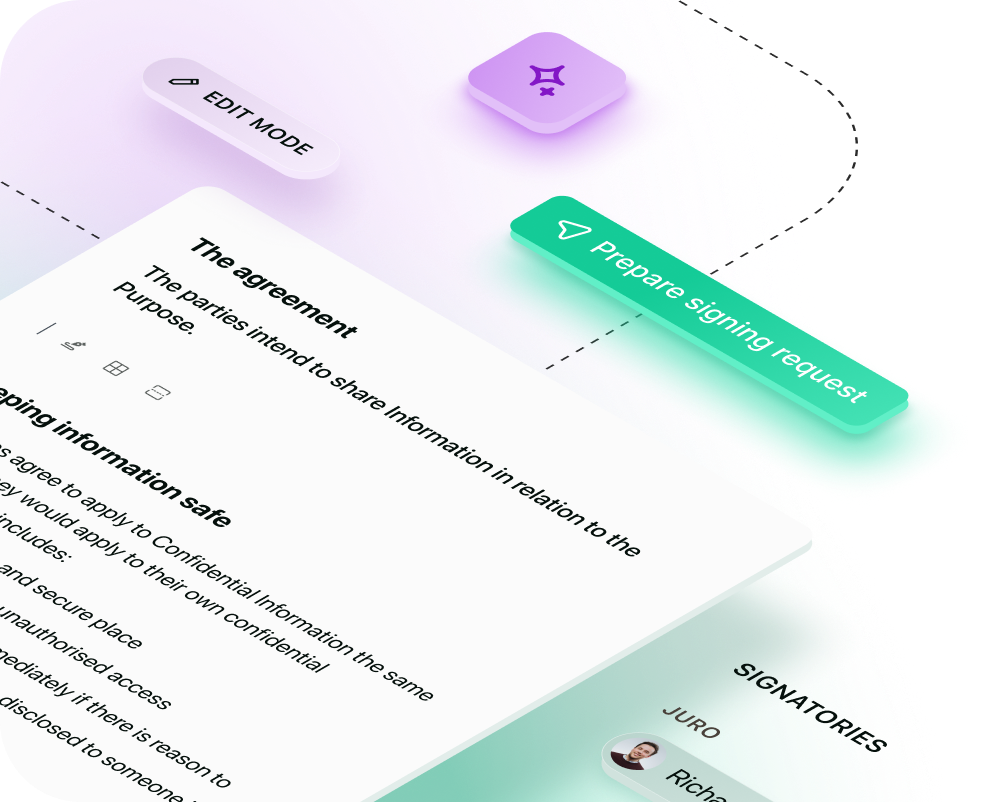Solutions
Customer Support
Resources
Use this free IT consulting agreement template to speed up the contracting process for your team.




This guide covers everything you need to know about IT consulting agreements, from their purpose and management to the main elements covered and the advantages of automating the process via a platform like Juro.
An IT consulting agreement is a contract between a company and an IT consultant or consulting firm. This agreement outlines the terms and conditions of the consulting services to be provided. It typically includes details about the scope of work, compensation, confidentiality, intellectual property rights, and termination conditions.
The main purpose of an IT consulting agreement is to provide clarity and legal protection for both the company and the consultant. Here are some key purposes:
1. Defining the scope of work. The agreement specifies the tasks and responsibilities of the IT consultant, ensuring that both parties have a clear understanding of the services to be provided.
2. Establishing compensation and payment terms. The agreement outlines how and when the consultant will be paid, including any key deliverables and timeframes that need to be met.
3. Protecting intellectual property. The agreement addresses ownership of any intellectual property created during the engagement, ensuring that the company retains rights to its proprietary information.
4. Maintaining confidentiality. The agreement includes confidentiality clauses to protect sensitive information from being disclosed to unauthorised parties.
5. Setting termination conditions. It defines the conditions under which the agreement can be terminated by either party, providing a clear exit strategy if needed.
Usually, IT consulting agreements are managed by various teams in a company, with the legal teams responsible for drafting, reviewing and approving the contract to ensure it follows laws and protects the company.
HR teams might also be involved in order to handle onboarding and offboarding of consultants, ensuring all paperwork is complete, while some elements might be managed by procurement teams, including contracting consultants, negotiating terms, and ensuring compliance with company policies.
In smaller companies, these tasks might be handled by one department or even one person, like the IT manager or a project manager.

IT consulting agreements are used in various scenarios to formalize the relationship between an IT consultant and their client. These agreements are critical in setting clear expectations, defining the scope of work, and protecting both parties involved. Here are common situations where IT consulting agreements are used:
In all these scenarios, IT consulting agreements help ensure that both the consultant and the client have a clear understanding of their roles, responsibilities, and the terms of the engagement, reducing the risk of misunderstandings and disputes.
To protect parties’ interests, an IT consulting agreement template should cover the following sections in sufficient detail:

Managing IT consulting agreements manually can be a complex and error-prone process. Specific steps involved include:
Legal teams draft the agreement from scratch or modify an existing IT consulting template, which often involves detailing technical requirements and project-specific terms, making it time-consuming and prone to errors.
Multiple stakeholders, including legal, HR, procurement, and IT departments, review the draft. This multi-departmental review can lead to delays and potential miscommunications.
The agreement may go through several rounds of negotiations with the consultant, involving changes to technical specifications, timelines, and payment terms. These changes are often tracked manually, which can result in version control issues and missed updates.
IT consulting contracts are often stored in various locations, such as email attachments, shared drives, or physical files, making it difficult to retrieve and manage them efficiently.
Manually keeping track of key dates, project milestones, and deliverables can lead to missed deadlines, incomplete deliverables, and potential legal and financial risks.
Managing IT consulting agreements manually can be a hassle, but Juro’s AI-native contract management system unlocks a streamlined and more efficient appraoch. Here’s how Juro enhances the process for IT consulting agreements:
Juro enables non-legal teams to independently generate, review, and approve IT consulting agreements. This reduces the reliance on legal teams for routine tasks, freeing up their time for complex issues and boosting overall productivity and efficiency.
Juro’s platform facilitates real-time contract collaboration among stakeholders, allowing seamless teamwork. This reduces bottlenecks and accelerates the contract lifecycle, moving contracts from drafting to execution up to 10x faster.
With Juro, everyone involved in the IT consulting agreement process remains aligned, minimizing miscommunication and delays.

Juro uses generative AI to draft IT consulting agreements quickly and accurately. AI tools help identify and mitigate risks, ensure compliance, and provide negotiation insights. This leads to faster, more informed decisions and reduced legal risk.
Juro stores all IT consulting agreements in a data-rich contract repository. This centralization provides comprehensive visibility into contract statuses, deadlines, and obligations, simplifying retrieval and auditing, and ensuring no agreement is ever lost or overlooked.

Juro’s contract automation software includes powerful analytics tools that offer real-time insights into the performance and risk of IT consulting agreements. By analyzing contract data, businesses can make better informed decisions, identify emerging or concerning trends, and address remove any bottlenecks from the contracting process before they cost the company.
Juro's AI-native contract automation platform empowers all teams to create, agree, execute and manage contracts up to 10x faster than traditional tools. To find out more, hit the button below to book your personalized demo.
Juro is the #1-rated contract platform globally for speed of implementation.


Juro embeds contracting in the tools business teams use every day, so they can agree and manage contracts end-to-end - while legal stays in control.
Book your demo